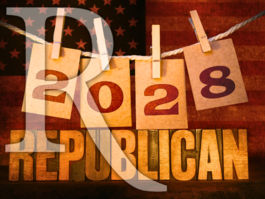Generic Congressional Ballot
Democrats Still Lead in 2026 Midterm Forecast
Less than a year before the next congressional elections, the Democratic Party maintains a lead over Republicans in the battle to control the House of Representatives.
The latest Rasmussen Reports national telephone and online survey finds that if the elections for Congress were held today, 45% of Likely U.S. Voters would vote for the Democratic candidate, while 42% would vote for the Republican. Five percent (5%) say they would vote for some other candidate, while another eight percent (8%) are not sure. (To see survey question wording, click here.)
The advantage for Democrats has shrunk slightly since July, when they led by four points, 46% to 42%. However, the position for Republicans is still a net six points worse than before the November 2024 election, when they led by three points (48% to 45%) and won just a razor-thin House majority.
Rasmussen Reports updates are also available on Twitter or Facebook.
The survey of 2,410 U.S. Likely Voters was conducted on November 18-23, 2025 by Rasmussen Reports. The margin of sampling error is +/- 2 percentage points with a 95% level of confidence. Field work for all Rasmussen Reports surveys is conducted by Pulse Opinion Research, LLC. See methodology.
The Democrats’ lead is mainly due to greater partisan intensity, while the two parties are now nearly tied among independents. Eighty-five percent (85%) of Democrats would vote for their own party’s candidate in the next congressional elections, compared to 81% of Republicans who would vote for the GOP candidate. Republican voters are more likely than Democrats to answer “not sure.” Among voters not affiliated with either major party, 36% would vote for Republicans and 35% for Democrats, while 12% say they would vote for third-party congressional candidates and 17% are undecided.
The “gender gap” is a net 11 points, as women voters prefer Democrats by a seven-point margin (47% to 40%) and men favor Republicans by a four–point margin (45% to 41%).
Forty-three percent (43%) of whites and Hispanics, 54% of black voters, and 40% of other minorities would vote for Democratic congressional candidates, while 45% of whites, 33% of black voters, 43% of Hispanics and 34% of other minorities would vote Republican.
Democrats now lead by 13 points (46% to 33%) among voters under 30, and also have a seven-point advantage (47% to 40%) among those ages 50-64. Republicans lead among voters between the ages of 30 and 49.
Eighty-six percent (86%) of self-identified liberal voters would vote for the Democratic congressional candidate, while 74% of conservatives would vote Republican. Democrats lead by a 21-point margin – 51% to 30% – among moderate voters.
Democrats lead among college-educated voters. Breaking down the electorate by income categories, Democrats lead by 13 points – 47% to 34% – among voters earning less than $30,000 a year, while Republicans have their biggest advantage among voters with annual incomes above $200,000.
Among those who voted for Donald Trump in last year’s presidential election, 81% would vote for Republican congressional candidates in next year’s midterms, while 86% of Kamala Harris voters would vote for Democrats.
The 2028 presidential primaries are still more than two years away, but Vice President J.D. Vance has an overwhelming early lead over other potential Republican contenders.
Trump earned a monthly job approval of 46% in November, down two points from October. three percent (53%) disapproved of his job performance last month, up two points from October.
Additional information from this survey and a full demographic breakdown are available to Platinum Members only.
Please sign up for the Rasmussen Reports daily e-mail update (it’s free) or follow us on Facebook. Let us keep you up to date with the latest public opinion news.
The survey of 2,410 U.S. Likely Voters was conducted on November 18-23, 2025 by Rasmussen Reports. The margin of sampling error is +/- 2 percentage points with a 95% level of confidence. Field work for all Rasmussen Reports surveys is conducted by Pulse Opinion Research, LLC.
Rasmussen Reports is a media company specializing in the collection, publication and distribution of public opinion information.
We conduct public opinion polls on a variety of topics to inform our audience on events in the news and other topics of interest. To ensure editorial control and independence, we pay for the polls ourselves and generate revenue through the sale of subscriptions, sponsorships, and advertising. Nightly polling on politics, business and lifestyle topics provides the content to update the Rasmussen Reports web site many times each day. If it's in the news, it's in our polls. Additionally, the data drives a daily update newsletter and various media outlets across the country.
Some information, including the Rasmussen Reports daily Presidential Tracking Poll and commentaries are available for free to the general public. Subscriptions are available for $4.95 a month or 34.95 a year that provide subscribers with exclusive access to more than 20 stories per week on upcoming elections, consumer confidence, and issues that affect us all. For those who are really into the numbers, Platinum Members can review demographic crosstabs and a full history of our data.
To learn more about our methodology, click here.





